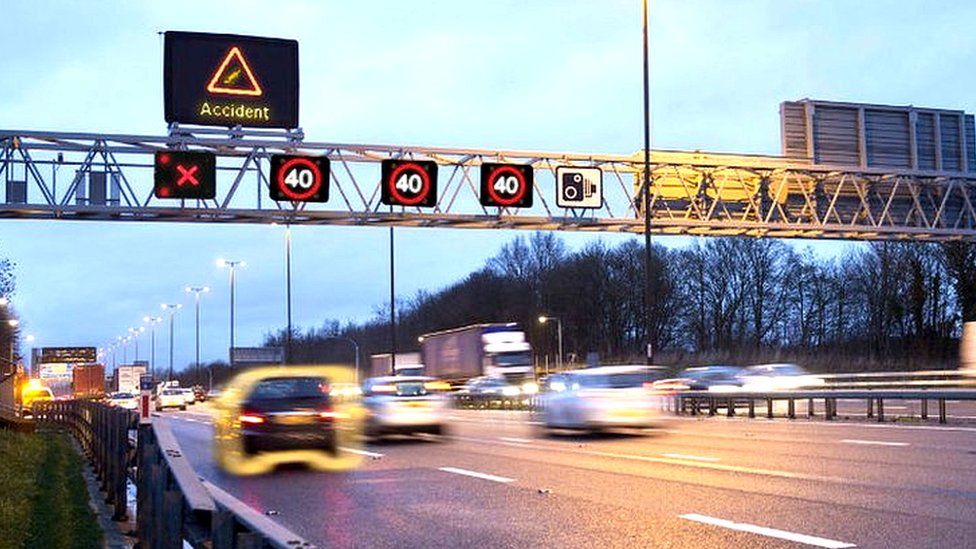Safety measures on all-lane running smart motorways are not working well enough, the transport watchdog says
 Image source, Gov.uk
Image source, Gov.ukTechnology aimed at improving safety on all-lane running smart motorways needs to be improved “urgently”, the transport watchdog has said.
Radar-based technology meant to improve the detection of stranded vehicles on smart motorways with no hard shoulder is falling short of targets, the Office for Rail and Road (ORR) said.
All-lane motorways are meant to ease congestion but critics say they have contributed to deaths.
Their rollout was paused in January.
The government is now collecting data on existing all-lane smart motorways to assess their safety before it allows any more to be built.
At the end of 2020 there were 369 miles of smart motorways in England, including 168 miles without a hard shoulder.
Stopped Vehicle Detection (SVD) was installed on every existing all-lane motorway by the end of September this year and is one of the measures designed to further improve safety on these types of motorways.
The ORR said that it was too early to see the full effects of SVD given the rapid rollout of the technology.
But it said that while SVD had “helped to reduce the duration” of breakdowns in live lanes, it was “not working as well as it should”.
Among other things the regulator said that “false detection rates” of breakdowns were too high.
ORR chief executive John Larkinson said: “It’s clear National Highways [the agency in charge of motorways ] needs to urgently improve its performance in this area.”
The watchdog said that National Highways was now “seeking rapid improvements” to the SVD technology to achieve “the required performance levels by the end of June 2023”, and the ORR would take further action if improvements do not happen.
National Highways said: “Our roads are among the safest in the world but every road death is a tragedy and we know there’s more we can do to further improve safety.”

What is a smart motorway?
A smart motorway is a stretch of road where technology is used to regulate traffic flow and – hopefully – ease congestion. There are three main types:
- Controlled, which have a permanent hard shoulder, but use technology such as variable speed limits to adjust traffic flows
- Dynamic, where the hard shoulder can be opened up at peak times and used as an extra lane; when this happens, the speed limit is reduced to 60mph
- All-lane running, where the hard shoulder has been permanently removed to provide an extra lane; emergency refuge areas are provided at intervals for cars that get into trouble
All three models use overhead gantries to direct drivers. Variable speed limits are introduced to control traffic flow when there is congestion, or if there is a hazard ahead. These limits are controlled by speed cameras.

The president of the AA motoring organisation, Edmund King, said the fact that the SVD system was not working effectively was “a major concern for drivers”.
“For ‘smart’ motorways to be truly smart and safe then the technology behind them must be fully effective,” he said. “If there are doubts about the technology, then the motorways are not smart and we should revert to tried and tested methods.”
RAC head of roads policy Nicholas Lyes said: “Breaking down in a live lane is terrifying enough but drivers must have confidence that the infrastructure is detecting them quickly so authorities can immediately close the lane.”
The ORR has also been assessing how well the Smart Motorway Action Plan put in place by the government in 2020 is working.
Under the plan, the government is collecting evidence on smart motorway safety and devising measures to improve their safety.
The ORR says it is too early to draw firm conclusion on success, but notes that “National Highways has achieved substantial improvements in attendance times for traffic officers”.
When it comes to response times, where there is more than one mile between safe places to stop, a national average below 10 minutes was achieved for the first time in September.
Overall, the ORR said that National Highways “appears to be on course to achieve its key safety target to halve the number of people killed or seriously injured on the SRN [Strategic Road Network] by 2025, compared to a 2005 to 2009 baseline”. The SRN comprises motorways and some A roads in England.
But it added there was a risk the number of casualties could increase if, as expected, traffic levels rise further in 2022 – as traffic numbers were still affected by the pandemic in 2021.